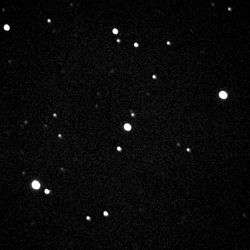WASP-1
 The star WASP-1. | |
| Observation data Epoch 2000 Equinox 2000 | |
|---|---|
| Constellation | Andromeda |
| Right ascension | 00h 20m 40.077s[1] |
| Declination | +31° 59′ 23.79″[1] |
| Apparent magnitude (V) | 11.79 |
| Characteristics | |
| Spectral type | F7V[2] |
| Apparent magnitude (B) | ~12.0[2] |
| Apparent magnitude (V) | ~11.8[2] |
| Astrometry | |
| Proper motion (μ) | RA: −4.706±0.078[1] mas/yr Dec.: −3.237±0.072[1] mas/yr |
| Parallax (π) | 2.5171 ± 0.0676[1] mas |
| Distance | 1,300 ± 30 ly (400 ± 10 pc) |
| Details | |
| Mass | 1.24 (± 0.17) M☉ |
| Radius | 1.382 (± 0.1) R☉ |
| Luminosity | 2.4 L☉ |
| Temperature | 6200 (± 200) K |
| Metallicity | 0.23 ± 0.08[3] |
| Other designations | |
| Database references | |
| SIMBAD | data |
| Extrasolar Planets Encyclopaedia | data |
WASP-1 is a metal-rich magnitude 12 star located about 1,300 light-years away in the Andromeda constellation.[3]
Planetary system
In 2006, an extrasolar planet was discovered by the Wide Angle Search for Planets team using the transit method.[4] The planet has a density of 0.31 to 0.40 g/cm3, making it about half as dense as Saturn, and one third as dense as water.
| Companion (in order from star) |
Mass | Semimajor axis (AU) |
Orbital period (days) |
Eccentricity | Inclination | Radius |
|---|---|---|---|---|---|---|
| b | 0.948+0.029 −0.028 MJ |
0.03958+0.00047 −0.00049 |
2.51994480±0.00000050 | <0.013 | 90.0+0.0 −2.9° |
1.514+0.052 −0.047 RJ |
See also
References
- 1 2 3 4 5 Brown, A. G. A.; et al. (Gaia collaboration) (August 2018). "Gaia Data Release 2: Summary of the contents and survey properties". Astronomy & Astrophysics. 616. A1. arXiv:1804.09365. Bibcode:2018A&A...616A...1G. doi:10.1051/0004-6361/201833051. Gaia Data Release 2 Vizier catalog entry
- 1 2 3 4 "TYC 2265-107-1". SIMBAD. Centre de données astronomiques de Strasbourg. Retrieved 2009-05-20.
- 1 2 Stempels, H. C.; et al. (2007). "WASP-1: a lithium- and metal-rich star with an oversized planet". Monthly Notices of the Royal Astronomical Society. 379 (2): 773–778. arXiv:0705.1677. Bibcode:2007MNRAS.379..773S. doi:10.1111/j.1365-2966.2007.11976.x.
- ↑ Cameron, A. Collier; et al. (2007). "WASP-1b and WASP-2b: two new transiting exoplanets detected with SuperWASP and SOPHIE". Monthly Notices of the Royal Astronomical Society. 375 (3): 951–957. arXiv:astro-ph/0609688. Bibcode:2007MNRAS.375..951C. doi:10.1111/j.1365-2966.2006.11350.x.
- ↑ Bonomo, A. S.; et al. (2017). "The GAPS Programme with HARPS-N at TNG . XIV. Investigating giant planet migration history via improved eccentricity and mass determination for 231 transiting planets". Astronomy and Astrophysics. 602. A107. arXiv:1704.00373. Bibcode:2017A&A...602A.107B. doi:10.1051/0004-6361/201629882.
External links
- "WASP-1". Exoplanets. Retrieved 2009-05-20.
- Image WASP 1
Coordinates: ![]()
This article is issued from
Wikipedia.
The text is licensed under Creative Commons - Attribution - Sharealike.
Additional terms may apply for the media files.